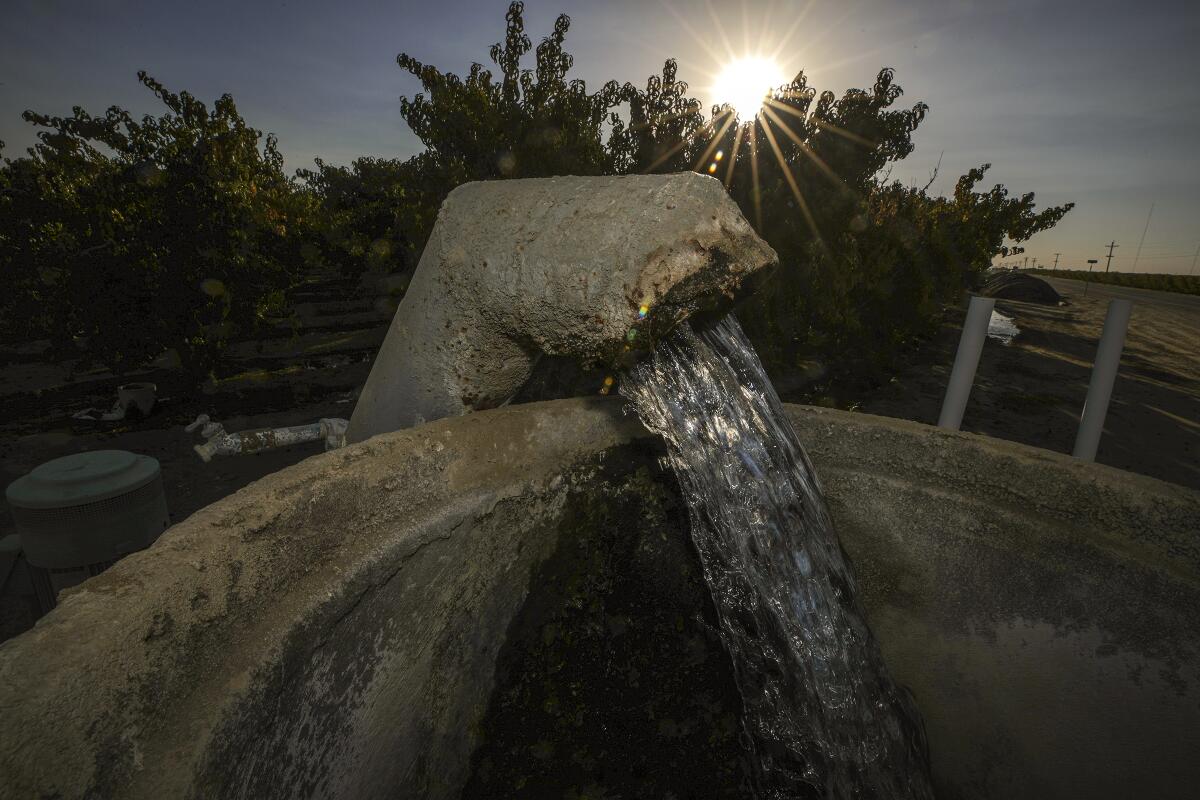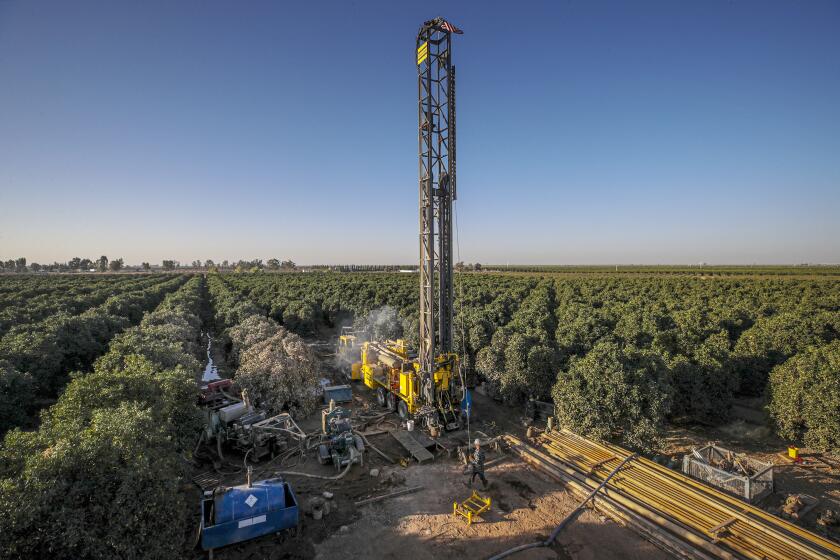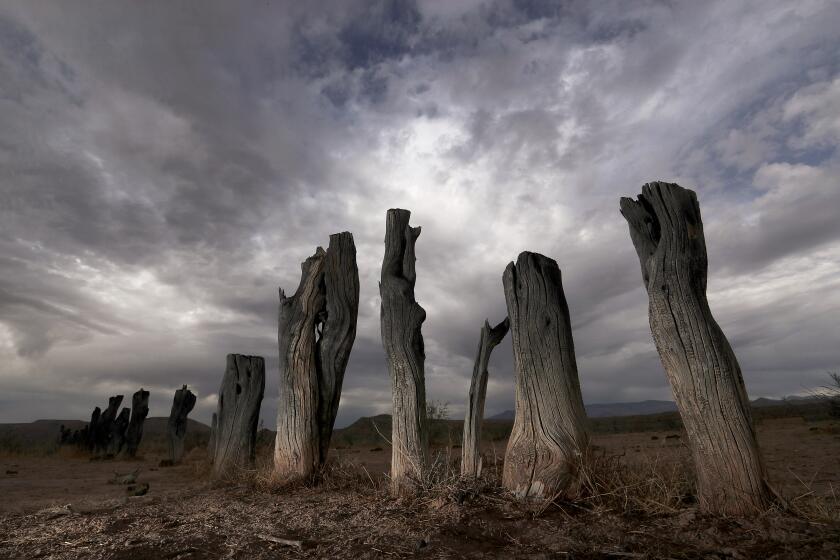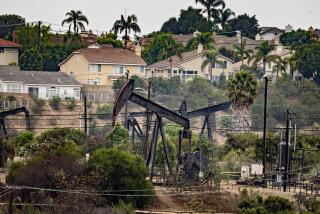‘A race to the bottom’: New bill aims to limit frenzy of well drilling on California farms

- Share via
In farming areas across the Central Valley, a well-drilling frenzy has accelerated over the last year as growers turn to pumping more groundwater during the drought, even as falling water levels leave hundreds of nearby homes with dry wells.
Counties have continued freely issuing well-drilling permits in the years since California passed a landmark law, the Sustainable Groundwater Management Act of 2014, which is intended to address the problem of excessive pumping over the next two decades to preserve groundwater.
Some state legislators are now supporting a bill that they say would strengthen oversight and limit the well-drilling frenzy by requiring a review of permits for new wells by the same local agencies that are charged with managing groundwater.
“It just makes common sense that the agency in charge of trying to get groundwater pumping into a sustainable yield should be able to weigh in on new wells going into that very same aquifer that they’re trying to monitor,” said Assemblymember Steve Bennett (D-Ventura), who introduced the bill.
Despite a California law intended to end over-pumping of aquifers, a frenzy of agricultural well drilling continues in the San Joaquin Valley.
The way the system stands, Bennett said, counties have been signing off on permits and agricultural landowners have been “rushing to get their wells in” before limits on pumping take effect.
“I think the rush to sink more wells will continue, if not accelerate, if we don’t have this,” Bennett said.
The bill, AB 2201, was approved April 26 by the Assembly Water, Parks and Wildlife Committee, and next goes before the Appropriations Committee.
The bill would require so-called groundwater sustainability agencies, which were established under the 2014 law, to weigh in on well permit applications.
Gov. Gavin Newsom in March issued a drought order that similarly prohibits local governments from granting a well-drilling permit if it would be “inconsistent” with the area’s groundwater management plan. Newsom’s order has slowed the drilling of new wells in parts of the San Joaquin Valley.
But the order brings only temporary measures during the drought, and the bill’s proponents argue a similar permanent change is necessary to protect vulnerable communities before more wells run dry.
The West is experiencing its most severe megadrought in a millennium, according to a new study. Scientists say climate change is playing a major role.
The legislation would prohibit a local government from approving a well permit unless it obtains written verification from the groundwater sustainability agency that the proposed well is “consistent” with the area’s management plan. Groundwater basins that the state deems high or medium priority would be subject to the requirement.
The bill would require agencies to post a notice of each well permit application online and allow 30 days for the public to comment. There would be an exemption for household wells or wells that supply drinking water.
Bennett said the fundamental problem is that new wells have been approved without an analysis of how the pumping will affect other wells in nearby communities.
“Disadvantaged communities need elected officials to stand up for them,” Bennett said.
Those who spoke in favor during the committee meeting included Ruth Martinez, from the community of Ducor in Tulare County.
As dams and global warming push endangered California salmon to the brink, a rescue plan is taking shape — and a tribe pushes for recovering their sacred fish.
Martinez said her community of about 600 people, mostly Latino farmworkers, long suffered with nitrate contamination in their drinking water, which meant they couldn’t safely use the tap water. In 2016, the community received a $1.8-million state grant and drilled a deeper well, nearly 2,000 feet deep, which has provided clean water.
But last year, a new agricultural well was drilled across the street from their well, which she said threatens the community’s water supply.
“The county approved this new well without thinking about the impact on our community,” Martinez told the legislators.
If the legislation had been in place, Martinez said, the local groundwater agency would have notified the community, and could have rejected the permit application.
Martinez, a board member of the Ducor Community Services District, said residents are concerned about the pumping.
“I am getting many calls and concerns from families about the decreased pressure and the lack of water coming from our taps,” Martinez said. “Our brand-new water is failing because the county did not protect us.”
The bill’s supporters include the group Community Water Center.
“It’s absolutely imperative that we connect and close the gap between land-use permitting decisions and sustainable groundwater management,” said Kyle Jones, the group’s policy director.
For groundwater management to succeed, he said, the state should stop the proliferation of new agricultural wells next to drinking-water wells.
The legislation is opposed by groups representing the agriculture industry.
Brenda Bass of the California Chamber of Commerce said the bill would “create a new permitting regime for groundwater wells that will negatively impact agricultural businesses” and food production.
A large portion of California’s water, roughly 80% of the supply that is diverted and pumped, goes to agriculture in a typical year, according to state data. The Central Valley’s farmlands produce almonds, pistachios, fruits and vegetables, and also supply large dairies.
Danny Merkley, director of water resources for the California Farm Bureau, said he thinks the bill conflicts with the “locally driven” approach that defined the 2014 groundwater law and is “premature.”
The new requirements under Newsom’s executive order should be given some time to play out “so we can identify the issues and fine-tune it,” Merkley said, before considering permanent legislation.
The water supplies that farms have long relied on, delivered by canals from the Sacramento-San Joaquin River Delta, have been cut back during the drought. Growers have traditionally turned to more groundwater pumping during dry times, and aquifer levels in the Central Valley have been declining for decades.
With climate change bringing hotter temperatures and intensifying droughts, the pressures on the limited supply of groundwater continue to mount.
The 2014 law is expected to eventually bring pumping limits that force growers to leave some farmland dry and unplanted.
Measurements by NASA satellites have documented the depletion of vast quantities of water over the last two decades. So much water has been extracted from aquifers in the San Joaquin Valley that the land is sinking as clay soils collapse, a problem that has damaged canals and cracked roads.
In the Tulare Basin, the ground is sinking at a rate of about a foot per year.
According to statewide data, more than 3,900 dry household wells have been reported since 2013, and the number of dry wells has risen dramatically over the last year. The state received reports of 975 household wells that ran dry in 2021, many in farming areas in the Central Valley.
An additional 162 dry wells have been reported so far this year.
The state Department of Water Resources recently reviewed plans submitted by local groundwater agencies and told agencies in farming areas of the San Joaquin Valley that their plans are “incomplete” and will require changes to address widespread risks of more wells going dry, as well as other problems.
“We have a real problem in California with the issue of water,” Bennett said. “We have a disconnect between those who are managing the basin for sustainable yield and those who are approving the sinking of the new wells at the same time.”
Bennett said he’s been thinking about the need to address the problem for some time, and he decided to introduce the bill after reading a Los Angeles Times article examining the well-drilling frenzy in the San Joaquin Valley. The analysis by The Times found that more than 6,200 agricultural wells have been drilled in the valley since the groundwater law was passed in 2014.
“I think that tipped the balance for me to say, ‘We’re going to do it this year,’” Bennett said.
He introduced the bill in January, and it has since been amended.
Because the bill faces opposition from agricultural groups, Bennett said he expects a “huge battle” to try to get it passed.
Fran Pavley, a former state senator who helped draft the 2014 law, said the bill is a necessary update.
“Can you allow an unlimited new number of wells to be added?” said Pavley, who is now environmental policy director at the USC Schwarzenegger Institute for State and Global Policy.
“There needs to be additional oversight on the local level,” Pavley said. “We’re still in a race to the bottom.”










